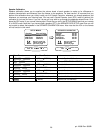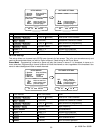
SETUP/CONFIGURE
You should always perform Setup/Configure after first installing your A/V System Controller and after
adding/changing speakers or sources or rearranging your listening area. If you have just completed the USER
PREFERENCE SETUP above you are already in the MAIN MENU. If not, follow the instructions above to get to
the MAIN MENU. Check that the remote is in AUDIO mode.
MAIN MENU
1 Help / Navigate
2 Product Information
3 Zone 2 Operation
4 Edit Preset Title
5 User Preferences
6 Setup / Configure
SETUP MENUS
1 Speaker Size and Delay
2 Speaker Calibration
3 Source Levels
4 AM Tuner Channels
move to new line
select menu page
exit menu system
↑ ↓
SEL
MENU
move to new line
select menu page
previous page
↑ ↓
SEL
MENU
5 FM Tuner Channels
activate SETUP MENUS
↵
(ENTER)
SEL or ENTER2
move to Setup/Configure
∧
(UP) or
∨
(DOWN)
(PAUSE) or
(STOP)
1
ActionFrom Front PanelFrom Remote
Speaker Size and Delay
The speaker size and delay menu lets you tell your A/V System Controller how many speakers you have in your
system, the relative size of the speakers, and their placement in the room. This is the most important setup
procedure you will perform. The A/V System Controller comes from the factory setup for 5 small speakers and a
subwoofer. If this does not match your speakers then audio information will be lost. For example, if you do not
currently have a center channel speaker and you do not perform this setup procedure, the center channel
information will be lost. If you perform this setup correctly, the A/V System Controller will know that you have no
center channel speaker and send this information to your front left and right speakers (along with the normal front
left and right information) so no audio information is lost.
About Speaker Size
- Speaker size literally refers to the size of your speakers. Audio material, particularly Dolby
Digital and DTS movies, often contain large amounts of bass. If this bass information is sent to small speakers
that are incapable of reproducing so much bass, then the bass information will be lost or distorted. MANY SMALL
SPEAKERS MAY BE DAMAGED BY TOO MUCH BASS. By telling your A/V System Controller the size of your
speakers, it will be able to intelligently route the bass to speakers that can reproduce it correctly. Typically, all
bookshelf or satellite speakers are considered small. Smaller floor standing speakers with single woofers 8” or
less should also be considered small. Floor standing speakers with 10” or larger woofers or multiple smaller
woofers may be considered large. These are general guidelines only - if you are unsure consult your speaker
manufacturer. If you have all small speakers we strongly recommend use of a subwoofer. If your front left and right
speakers (or more) are large then you may not require a subwoofer, but you may still get better results using a
subwoofer, especially with Dolby Digital and DTS movies.
24
p/n 12698 Rev. 9808B


















